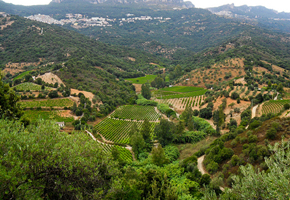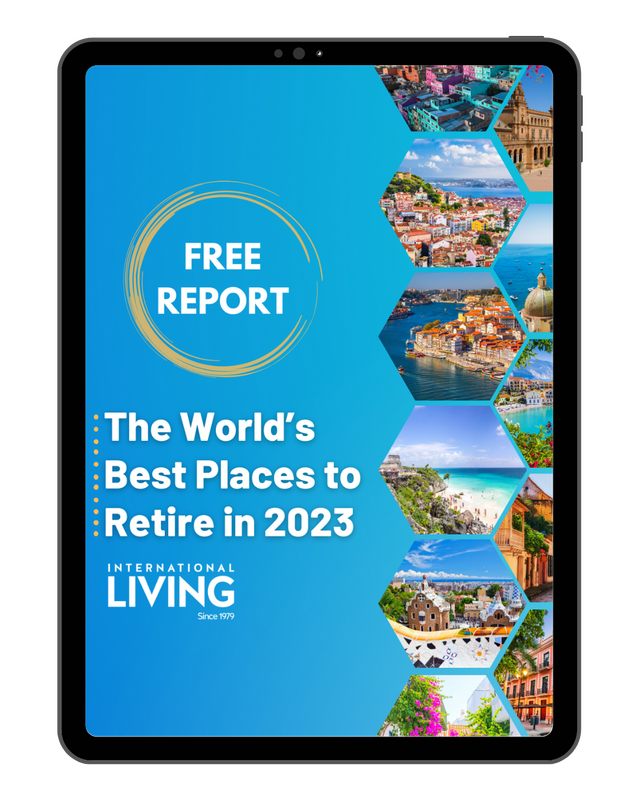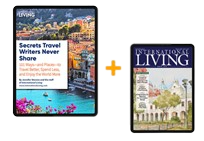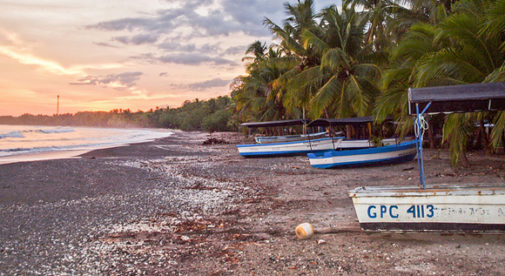Optimism and purpose, a low stress level, a natural diet and an active lifestyle…experts say these factors are three times as important as your genetic makeup when it comes to enjoying a long and healthy life. Luckily, it’s easy to embrace those elements when you’re living in a place where they come naturally. And they do in our top picks for the world’s healthiest places to live.
In these healthy havens, people put great value on personal interaction and friendship—and that involvement keeps you engaged every day. A slower pace—often coupled with a much lower cost of living—relieves the pressure and anxiety that so often takes grip at home. The foods you find at the markets are always fresh, local and organic, the air is clean, and the sun shines.
If you’re ready to escape to a place where you’ll feel better, look younger and live longer, here’s your short list:
1. Volcán, Panama’s “Shangri-La Valley”
“Live long and prosper.” In the famed Star Trek series, it was the typical Vulcan salute. And that brings Volcán to mind for several reasons. What better place in Panama to seek long life and live virtually off the grid?
Expat Patrick Greer, owner of the Lost and Found eco-lodge, says few places rival Volcán for green-highland scenery and low-cost living. But he and other expats are cottoning on to the health benefits of living here.
Check out the cemetery gravestones and you’ll note people in this region were living into their 80s and 90s when life expectancies elsewhere in Panama averaged 77 years or less. It’s a combination of the spring-like weather and the fresh food…seafood caught daily, free-range eggs and chicken, and more.
Often described as the “Shangri-La Valley,” Volcán’s attractions include thermal springs and some of the best birdwatching in Panama. Just try to stress out here; it’s hard to do—the pace of life is so serene.
Not only that, but the Chiriquí province—where Volcán is located is known as Panama’s breadbasket. About 80% of the nation’s produce comes from here. There are larger farms producing everything from coffee to fruit and vegetables, and smaller outfits supplying the increasing demand for specialty crops—hydroponic lettuces, organic herbs, exotic fruits and flowers, pesticide-free vegetables, and much more.
Patrick’s lodge is in a national park with dozens of hiking trails. “We are surrounded by tranquility,” he says. “Hordes of monkeys come through the trees…cacomistles appear every night at eight like clockwork.” His neighbors include an organic farmer who specializes in coffee and makes his own wine. You can sample both and have a farm-to-table lunch, then lose yourself under the green canopy of La Fortuna nature reserve.
2. Centenarians in Costa Rica’s Nicoya Peninsula
“Blue Zones” have been determined by scientists as places where the world’s longest-living people reside. One of these is Costa Rica’s Nicoya Peninsula (pictured above) on the country’s northwest coast. In 2007, researchers spent nine months there to determine why so many people live well into their 90s and 100s—longer than anywhere else in Costa Rica…or the world, for that matter.
The scientists studying the centenarians of the Nicoya Peninsula found eight key reasons for this longevity:
- Diet. The people here are heavily influenced by the diet of the Chorotega, an indigenous group, which consists of high-fortified corn and beans—healthy and high in fiber.
- Water. With loads of calcium, the hard water encourages strong bones and fewer hip fractures.
- Family focus. The Nicoya centenarians tend to live as couples or with children and/or other family members from whom they get support.
- Eating lightly. They eat a light dinner early in the evening. (Eating fewer calories is proven to add years to your life.)
- Dry climate. Nicoya is one of the sunniest and driest parts of Costa Rica, and in dry climates food doesn’t spoil as quickly, the sun is more intense (so people get more Vitamin D), and residents get fewer respiratory diseases.
- Social networks. The centenarians here get frequent visitors and they know how to listen, laugh, and appreciate what they have.
- Work. They’ve enjoyed physical work all their lives and find joy in everyday chores.
- Purpose. They feel needed and want to contribute to a greater good.
3. Vilcabamba, Ecuador: The Valley of Longevity
Why can natives of Vilcabamba’s “Valley of Longevity” live longer, healthier lives? Maybe it’s the pollution-free environment or the highly oxygenated air. It could be the unique combination of minerals in the water or the abundance of negative ions emanating from the mountains and fast flowing rivers. Easy access to natural medicines, largely unavailable in developed countries, is another possibility.
While all these factors can contribute to a longer, healthier life, they aren’t the typical reasons expat residents give when they explain why they feel so much better living in Vilcabamba. A more typical response will reference the valley’s magnificent weather.
The health benefits may not be immediately obvious. But this consistently good weather means your body doesn’t have to expend energy adapting to climatic extremes. Windows can be open 24/7, filling your house and your lungs with crisp, clean air.
Vilcabamba’s idyllic year-round weather means anytime-access to fresh, tasty and inexpensive fruits and vegetables. And it’s easy to get up and go when the weather outside is so good. How can your doctor and your body not like that?
But it’s not just Vilcabamba’s atmosphere that helps make the area a healthy place to live; there’s also Vilcabamba’s “attitude.” Stress, the stealthy destroyer of a person’s physical and mental well-being, is no match for the valley’s ambience. Resident’s laid-back approach, combined with Vilcabamba’s spectacular scenery, can make anyone’s disposition as wonderful as the weather.
4. Sardinia: Ancient Island, Ancient People

Off Italy’s Mediterranean coast, Sardinia is a rugged island of 1.3 million people. It’s often synonymous with the jet-set lifestyle.
Sardinia is another Blue Zone. Due to their extraordinary number of centenarians, the close-knit villages of its interior have attracted several major research teams.
Dan Buettner, a noted author on longevity, interviewed several centenarians in mountain region of Barbagia for National Geographic. (Tavern calendars here feature a “Centenarian of the Month.”)
Most still live with one or more family members. The men are shepherds and continue that lifestyle. They typically walk five miles a day and eat similar diets: whole grain flatbread, fava beans, tomatoes, greens, garlic, various fruits, olive oil and pecorino cheese from grass-fed sheep (high in Omega 3). Among older people, meat often remains reserved for Sundays and feast days.
The local wine is Cannonau, a dark, red wine with the world’s highest levels of antioxidants.
5. New Zealand: Healthy Living Kiwi-Style
Home to 4.4 million people, New Zealand and its awesome landscapes are admittedly a long way from North America. But as our winter is their summer, you could consider retiring here part-time. In a pollution-free environment, it’s much easier to embrace a healthy lifestyle.
Those of working age may have a skill that New Zealand needs. Most transplants find their work-life balance changes for the better. There’s less stress, and health care is affordable and often free. For both sexes, average life expectancy is two years higher than in the U.S. Here, it’s 83 for women and 78 for men.
Its “outdoors lifestyle” isn’t all about high-octane adventure or team sports like rugby. The most popular participation sports are walking and hiking. Surveys suggest that 64% of adults go “tramping.” Many families own a small boat, and fishing and swimming opportunities abound. No matter where you live, nowhere is more than a 90-minute drive from the ocean.
A Colorado transplant, Jill Chalmers moved to New Zealand with her Kiwi husband. “Everyone, young to old, always seems to be doing something active,” she says. “People just get out and do things. It’s easy to join in.
“Plus there’s an abundance of healthy whole foods. We eat fresh seafood (we often catch it ourselves) and local organic fruits and vegetables. Everyone grows something here and neighbors all put out bags for purchase by anyone. We get fresh lettuce from the kids’ school, avocados from our tree, and kiwis, apples and plums from our neighbors.”

Get Your Free Report on the World’s Best Places to Retire:
Learn more about the best places in the world to retire in our daily postcard e-letter.
Simply enter your email address below to sign up for our free daily postcards and we’ll also send you a FREE report on The World’s Top 10 Retirement Havens, plus access to over 10 more free reports. Our gift to you, on our favorite destinations.
Related Articles
The Cheapest Places in the World to Live
5 Countries with the Best Healthcare in the World
Upcoming Conferences
The Only 2024 Fast Track Panama Conference
If your dream retirement involves stunning beaches… lush green mountains… a warm climate with no hurricanes… first-rate healthcare… incredible value for money (a couple can live well on $2,200 a month)… and the World’s #1 Retiree Discount Program…
Join our Panama experts and expats in February and discover why Panama could be your perfect paradise.



.png)